Menus
- On the move with 400 two-stroke engines
- The sound makes the music
- Kawasaki KH 400 weighs 174 kilograms
- Yamaha DT 400 – 400 cm³ in one pot
- First real and specially developed Yamaha enduro
- Early switching brings more here
- Yamaha RD 400 in first hand
- Sheer driving performance with a wonderful bite are tempting
- In detail: Kawasaki KH 400
- In detail: Yamaha DT 400
- In detail: Yamaha RD 400
- Opinions
- Offers for classics from the 1970s
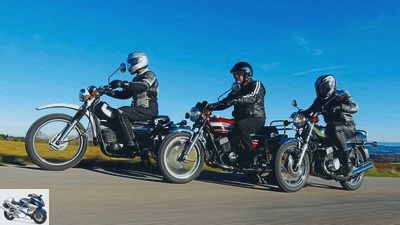
bilski-fotografie.de
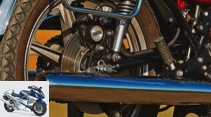
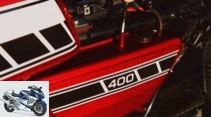
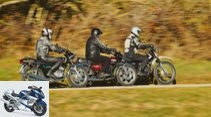
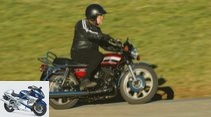
27 photos
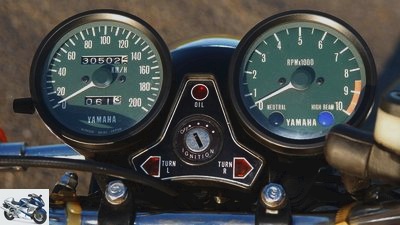
bilski-fotografie.de
1/27
In the well-stocked, clear RD cockpit, there are all the necessary warning lamps, including an oil level indicator lamp
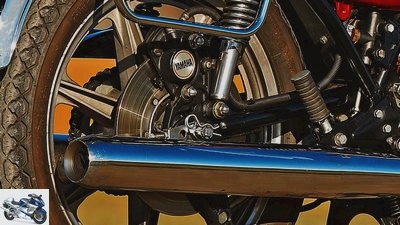
bilski-fotografie.de
2/27
The three-way adjustable struts at the rear do a decent job, the disc brake built into the rear wheel shines in terms of effectiveness and controllability
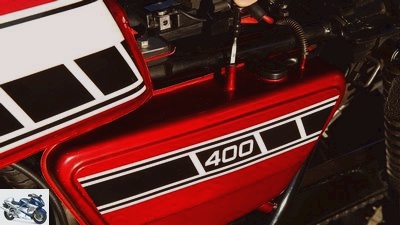
bilski-fotografie.de
3/27
The level in the two-stroke oil tank can be checked using the dipstick in the side cover – better safe than sorry
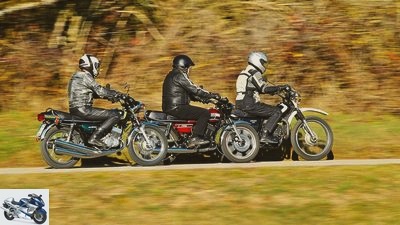
bilski-fotografie.de
4/27
Kawasaki KH 400, Yamaha DT 400, Yamaha RD 400
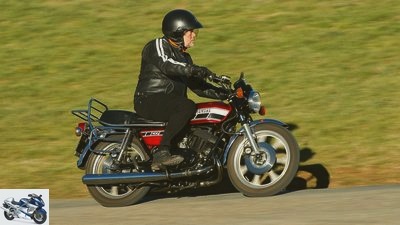
bilski-fotografie.de
5/27
The RD 400 marks the top of the air-cooled Yamaha two-stroke engine
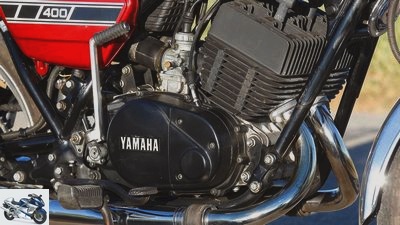
bilski-fotografie.de
6/27
Yamaha RD 400
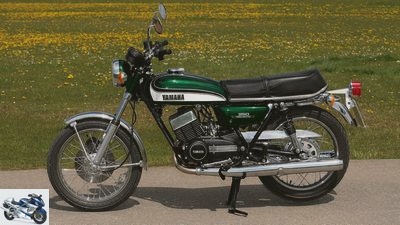
bilski-fotografie.de
7/27
1973: The 39 hp, more rounded predecessor, the RD 350, offered from 1973 onwards still had spoked wheels, but already had the membrane control.
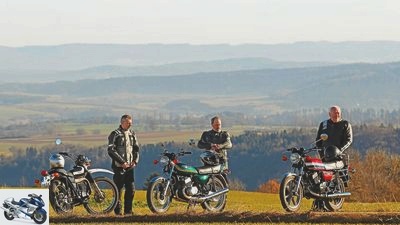
bilski-fotografie.de
8/27
Kawasaki KH 400, Yamaha DT 400, Yamaha RD 400
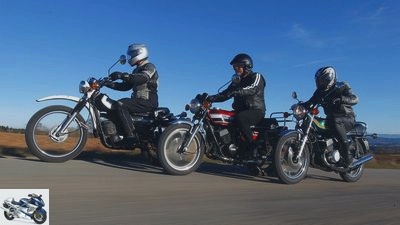
bilski-fotografie.de
9/27
400 two-stroke: Kawasaki KH 400, Yamaha DT 400, Yamaha RD 400
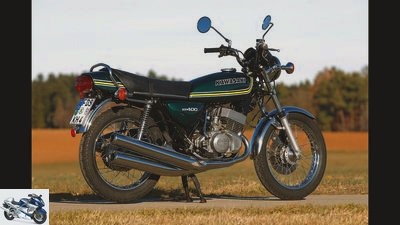
bilski-fotografie.de
10/27
Kawasaki KH 400
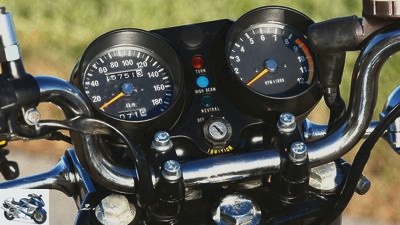
bilski-fotografie.de
11/27
Deeply recessed, but not entirely glare-free scales in the Kawa cockpit in the suggested egg cup style.
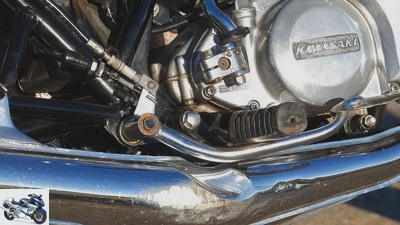
bilski-fotografie.de
12/27
With a powerful, curved brake pedal over a matching exhaust dent…

bilski-fotografie.de
13/27
…the rear drum brake is operated by a cable. The exhaust innards of the three distinctive pipes should neither be vibrated loose nor rusted – replacement is expensive
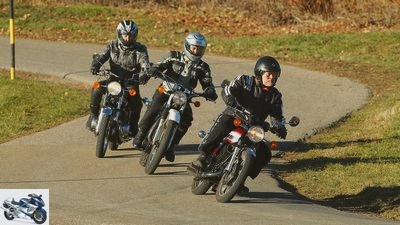
bilski-fotografie.de
14/27
Kawasaki KH 400, Yamaha DT 400, Yamaha RD 400
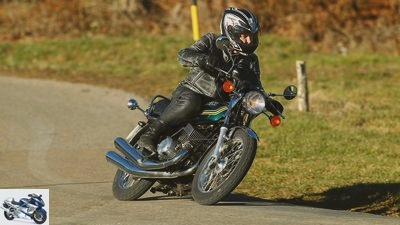
bilski-fotografie.de
15/27
The 400 triple is considered the most harmonious of all Kawasaki three-cylinders
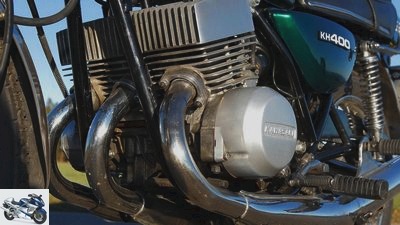
bilski-fotografie.de
16/27
Kawasaki KH 400

bilski-fotografie.de
17/27
1971: The 350 S2, which was only offered until 1973, was very poisonous with its 42 hp, but also very thirsty. It also slowed down moderately and vibrated heavily.
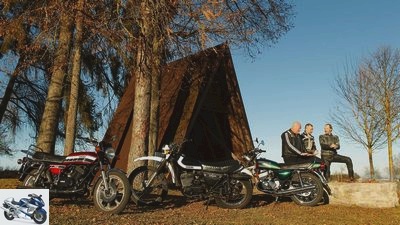
bilski-fotografie.de
18/27
Kawasaki KH 400, Yamaha DT 400, Yamaha RD 400
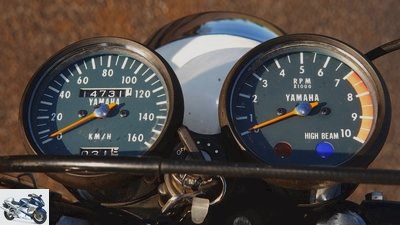
bilski-fotografie.de
19/27
The dials in the thrifty cockpit of the DT offer reserves: you stay just as far away from 160 km / h as from the red zone from 7000 rpm.
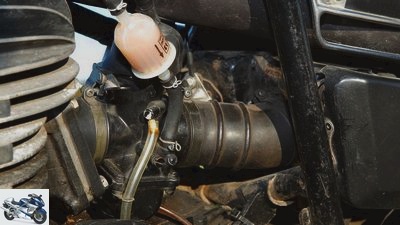
bilski-fotografie.de
20/27
The 32 mm Mikuni carburetor has its choke lever easily accessible right under the fuel filter.
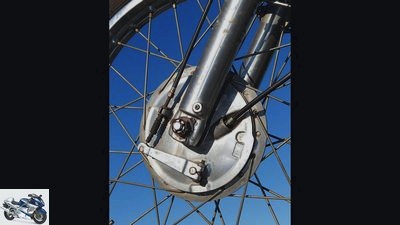
bilski-fotografie.de
21/27
The small drum brake decelerates quite well at first, but after a few braking it fades
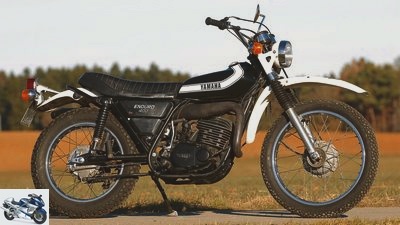
bilski-fotografie.de
22/27
Yamaha DT 400
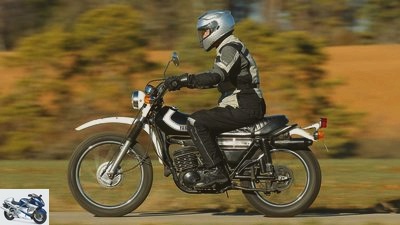
bilski-fotografie.de
23/27
The DT stew starts stomping loudly and with a bassy sound from 2000 rpm
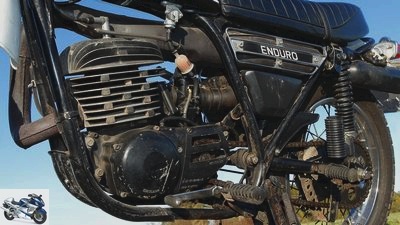
bilski-fotografie.de
24/27
Yamaha DT 400
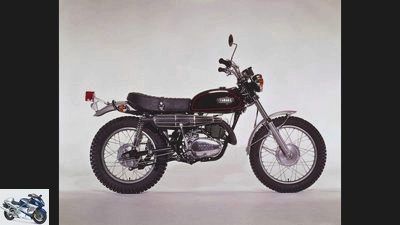
25/27
1970: The start of the high-displacement two-stroke enduro bikes was the RT1, which was clearly based on the 250cc. Initially with 30 HP, from 1972 with membrane control and 32 HP.
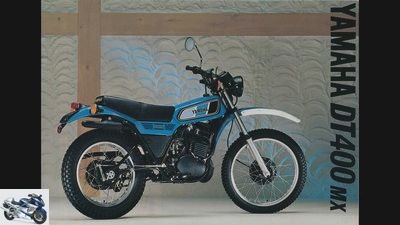
26/27
1977: No more twin shock: From 1977 Yamaha introduced cantilever rear suspension with the DT 400 MX and made the design more angular.
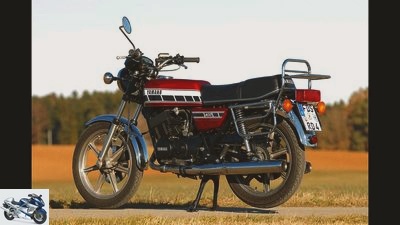
bilski-fotografie.de
27/27
Yamaha RD 400
Kawasaki KH 400, Yamaha DT 400 and Yamaha RD 400
On the move with 400 two-stroke engines
Content of
The air-cooled 350s were in a class of their own for a long time. Then they were replaced by the 400s, and in the mid-1970s the two-stroke fan even had a choice: one, two or three-cylinder? A comparison of the dissimilar characters.
The sound makes the music
ZWeitakt fans of old age will fondly remember the late 1970s, the time of the variety of models and the burgeoning crazy performance. This usually met with low weight and enabled driving performance with which the drivers of the small poisonous dwarfs managed to pester the owners of the large-volume, high-horsepower four-stroke engines. And if you wanted to rise above the 250 and 350 and (financially) could, you could even choose between one, two or three cylinder bikes in the 400 class. What a luxury. Especially since the selection went hand in hand with the enjoyment of three noticeably very different characters. Hearty rumbling stew, powerfully tugging two-cylinder or brightly sawing three-cylinder – everyone has the engine they like.
Buy complete article
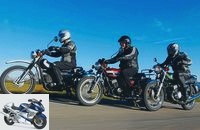
Kawasaki KH 400, Yamaha DT 400 and Yamaha RD 400
On the move with 400 two-stroke engines
"Nothing below, everything above"
Edgar Scherrmann likes different characters and would probably find it difficult to choose. But he doesn’t have to, he owns two of our three photo bikes – the two-cylinder RD 400 and the three-cylinder KH 400. He has only had the latter in his garage since 2015 and has given it a technical overhaul and visual maintenance since the purchase. It was only finished a few weeks before our departure and today it shines almost like new in a wonderful candy dark green and shiny chrome.
Acoustically, too, the Kawa-Dreier was always distinctive and unmistakable. This already applied and even more clearly for the predecessor 350 S2, which was to bring a breath of fresh air into its class in 1971. This is what it did with its 42 hp at 8,000 rpm and with angry performance characteristics of a lethal syringe from the brand “Below nothing, above everything”, it provided the right image of the impetuous predator. Including vibrations, which the motor, which is rigidly bolted to the frame, passed on to the driver. Due to increasingly stricter noise regulations, the triple was given a cubic capacity reduction and the 350 was made into a 400. The maximum output achieved at 7,000 rpm was left at 40 hp, in favor of a more even output thanks to the less extreme coordination. The 400 S3 remained in the range for three years until, according to triple experts, Kawasaki launched what is probably the best, most sophisticated and most suitable model for everyday use on the market in 1976: the KH 400. Now with an engine suspended in rubber bearings, power now reduced again to 36 hp and contactless CDI Ignition instead of the high-maintenance contact ignition. It no longer offers the tough bite and the maneuverability of the predecessor models, but it still offers good performance with meanwhile more moderate consumption.
Kawasaki KH 400 weighs 174 kilograms
We want to find out about the two-stroke bite for ourselves today, so I jump on the Kawasaki as part of a driver swap. As the only one of the trio, the Kawa affords the luxury of a choke lever on the left handlebar fitting instead of directly on the carburetor, but I will hardly operate it – the triplet has already warmed up. One or two steps on the Kickstarter, then high-frequency singing two-stroke saws can be heard from the three pots. The triple sounds not as loud as expected, rather cultivated and good. Comfortable, almost touristy, the accommodation of the driver – quite high, comfortably cranked handlebars, not too sporty placed pegs, wide, if somewhat angular seat bench that fits. The KH can be started up without clutch-killing speed orgies and the engine hangs well on the gas, revs up cleanly, even if it is more restrained around the bottom. The gears of the five-speed gearbox engage crisply and precisely, and the KH can be moved without any stress. She only shows her other face when I let the gas stand on the next longer straight and give her the spurs on the third. From 5,000 tours the picture changes, there is a fire in the booth and under bright triple saws the speed snaps up. The tamed KH no longer reveals the absolute revving pleasure, the bite already subsides before the red area. But anyone who moves between 5,000 and a good 7,000 rpm always has enough pull on the chain to make his country road area unsafe. The great handiness of the 174 kilogram machine also contributes to this.
Yamaha DT 400 – 400 cm³ in one pot
There is also nothing to complain about in terms of stability, despite the rear swing arm, which is stored in cheap plastic bushings. No wobbling or wobbling spoils the driving pleasure, brisk chase is at best countered by the front brake, which only decelerates somewhat when the lever is pulled hard. The rear, cable-operated drum brake is unfortunately not of great help. The vibrations of the triplet are pleasingly low – only very fine at high speeds, but never annoying, almost nonexistent in the lower range, the engine delights with great smoothness and the finest manners. There is no longer any trace of the former rough and rough leg. The notorious two-stroke flags and high oil consumption are also not noticed here today. The oil pump (the test once determined a consumption of 0.4 liters per 100 kilometers) seems to be well adjusted.
From the silky three-cylinder back to the Yamaha DT 400, which had already been moved for the photo – what a blatant change in terms of character and smoothness. The original DT 400 in a decent but used condition belongs to Dominik Tress. The 37-year-old runs a parts trade near Stuttgart and is probably hoarding one of the richest stocks of DT 400 parts in this country. Our photo copy was offered to him a good three years ago; before that, it was in the hands of women and in family ownership for over 30 years. The technically well-checked and partly overhauled, otherwise unrestored DT can come up with age-usual patina and has the charm of honest skin. Tress has not driven much since the purchase, and the stew had been standing still in the shed for a long time before our photo session. So it doesn’t cause any problems – the single-cylinder wakes up with choke support on the third step when it is started for the first time in the morning and grumbles loudly to itself with a bassy two-stroke rattle while idling. For a two-stroke, the single demands unusually courageous kicks at the start, despite the automatic decompression device. 400 cm³ in one pot is just an announcement.
First real and specially developed Yamaha enduro
Let us take a quick look back: While the first off-road two-stroke Yamahas were still retrofitted offshoots of the road machines, the DT1, available from 1968, can be considered the first real, new and specially developed Yamaha enduro. Particularly from the USA, strong demand reached the factory in Japan, where it was decided to act. Although this 250 was not bad in the forage, a larger-capacity variant with a newly developed engine (more bore and more stroke), 351 cm³ and a proud 30 hp was added in 1970: the RT1. A robust, rough leg that could strike back when stepping up. In 1971 the problem with the decompression system was somewhat alleviated. The RT1 and the subsequent versions RT1B, RT2, in which the membrane control was introduced, and RT3, now with a 21-inch instead of 19-inch front wheel, was followed in 1974 by the DT 360 – with a longer wheelbase and CDI ignition.
With the enlargement of the bore to 85 millimeters, Yamaha nailed the nail in 1975 and the DT became the 400. With a 32-series Mikuni carburettor and constricting soundproofing, the 397 cm³ engine produced “only” 25 hp, but it delivered plenty of torque. For the model of the following year 1976, two transfer ducts were added to the previous five, but otherwise only the color scheme was changed. In 1977 the more angular styled DT 400 MX with central spring strut replaced the previous Twin Shock models.
Early switching brings more here
Dominik’s machine is a DT 400 B, i.e. a 1975 with just over 14,000 kilometers on the clock. Instead of driving up and down for the photographer in a disciplined manner as before, I now grab the DT for a few laps of “free driving”. In addition to the pithy, bassy background noise, I noticed right from the start how powerful the single is, even just above idle. Starting at around 2,000 rpm? No problem. And from this point onwards, the single pushes forward impetuously, displaying manners that are almost suitable for trials. He plows beefy through the speed range, which ends much earlier than with the competitors. Already at 4,500 rpm it gets much tougher, and anyone who absolutely wants to turn up to 5,500 rpm is wasting time – early shifting brings more here.
The full blow of the stew is always noticeable, the vibrations change at most their frequency, hardly their intensity. But you don’t blame the single, yes, you actually expect it. Just as you would expect a vise-like handshake from a lumberjack in a plaid shirt. Anyone who has booked Offroad gets Offroad. Although we don’t want to try these qualities today (spring travel only 140 mm at the front, only 80 mm at the rear, but a decent 240 mm ground clearance), the DT shouldn’t be swallowed up or maltreated too much. It was said that it was designed to be a little top-heavy, which reveals itself on closer observation when driving swiftly changing bends. Although the DT is super light at 141 kilos and can be angled very easily, the large 21-inch front wheel with its gyroscopic forces also needs to be conquered. The relaxed seating position with the high and wide handlebars contribute to the maneuverability – everything is perfectly arranged and comfortable. Slightly longer shift travel urges careful gear changes, and the jump between second and third gear is quite large – otherwise everything is okay.
Yamaha RD 400 in first hand
In addition to the knobby tires, which should be enjoyed with a bit of caution, the effect of the two drum brakes is at best counteracting all too rough cornering. If the front one even packs surprisingly hearty at the beginning, its effect leaves much to be desired after a few braking – fading is clearly an issue. Once you have adjusted to this and adjusted your driving style, you can use the DT to dash down small country lanes of the third order with pleasure and stress-free, with refreshing short intermediate sprints and small detours through fields, forests and meadows. However, you should keep the nearest gas station in mind – the nine-liter tank does not allow too long a range.
It is precisely for such occasional, small escapes that Dominik uses and loves his DT. Would he give her up? Maybe if the price is right. He has enough other bikes in his collection. The same applies, as mentioned, to Edgar, the owner of the other two bikes. He also has a few other motorcycles available for trips, but he would hardly part with his KH 400 and certainly not with the RD 400. After all, he bought the latter back in 1976. An RD 400 in top condition in first hand – how often do you find something like this? Practically never. The 400 series was offered between 1976 and 1980 – but the sales figures remained manageable. Not because of an absurd new price, because at 4,500 marks it was on a very competitive level with the KH 400. Rather, the 43 hp RD 400 troubled the fact that it was about twice as expensive with an annual premium of 1,500 marks in insurance like a 27 hp machine. Probably one reason why Kawasaki had recently offered a 27 hp version of the KH 400. Even then there was disagreement about the move away from the rounded shapes to the angular “Sargtank-RD”, but the now frowned upon (somewhat heavier and clunky) cast light alloy wheels instead of the classic spoked wheels were a hit back then. The motor qualities of the long-stroke 400 are still undisputed today. Its stroke was increased from 54 (RD 350) to 62 mm, which also required a new crankcase. The power development of the engine, which is only four HP stronger with 43, convinced from the start with significantly better pulling power.
Sheer driving performance with a wonderful bite are tempting
So much for the prehistory. Now I want to experience for myself how the much-vaunted Yamaha RD 400 pulls the corners of your mouth wide. The start succeeds with a relaxed step, and with the first robust, self-confident sounding “Rengdengdeng”, the RD seems to want to make it clear who the Kapo is here. As expected, the twin is somewhere between one and three-cylinder when it comes to vibrations. Well, maybe closer to the single – noticeably in any case. Expected greedily, the engine hangs on the gas, needs little speed when starting, is easy to handle and reveals more pulling power than the KH-Triple even in the lower speed range.
While the KH 400 looks slim and delicate, the RD with its ultra-short wheelbase and the seating position that feels far forward and close to the handlebars looks even more bicycle-like. This combination is what makes it so special – it feels as if you’re sitting on a 250, with the power of a 500. In any case, what the RD flares up from 5500 tours does not have to hide in the half-liter class. The hammer falls, it pulls your arms out, and accompanied by a fine tingling sensation and snotty two-beat chirping, the ride continues just as briskly after a short click into the next gear. The short overall ratio and the well-chosen gear steps support the rapid propulsion. The driving behavior leaves little to be desired in terms of handiness and driving stability, the RD can be bent jaggedly around the corner. The deceleration is also jagged, the front of the two disc brakes responds somewhat bluntly at first, but then offers official deceleration, the rear system brakes simply grandiose and easy to adjust. The 400 series is also progressive in terms of equipment: turn signal switch with reset at the push of a button, tidy, easy-to-read cockpit with oil level warning light. The contact ignition, which is subject to wear and tear, was not replaced by a contactless CDI ignition until the model update in 1978. The 2R9 model was then also pepped up in design and got a short tail. Again a matter of taste – I like it.
Would the RD be my favorite? Hard to say. The sheer performance and the wonderful bite are tempting. But also the cool start of the rustic DT and the silky run with the brightly sawing sound of the KH. Fortunately, I don’t have to choose – even if I was looking for one, all good specimens are in safe hands anyway. Take care of them and keep us the witnesses of the wild seventies!
In detail: Kawasaki KH 400
bilski-fotografie.de
Kawasaki KH 400
Data (Type KH 400 A3)
Engine: Air-cooled three-cylinder two-stroke in-line engine, slot control, bore x stroke 57 x 52.3 mm, displacement 400 cm³, compression 6.5: 1, output 36 HP at 7,000 rpm, Mikuni round slide carburetor, Ø 26 mm, contactless CDI ignition
Power transmission: Multi-disc oil bath clutch, five-speed gearbox, chain drive
Landing gear: Double loop frame made of tubular steel, telescopic fork at the front, two-arm swing arm made of tubular steel, hydraulically damped struts, tires 3.25 S 18 front, 3.50 S 18 rear, front disc brake, Ø 277 mm, single-piston floating caliper, simplex drum brake at the rear, Ø 180 mm
Mass and weight: Wheelbase 1,365 mm, weight with a fully fueled tank 174 kg, tank capacity 14 liters
Driving performance: Top speed 168 km / h
technology
With four millimeters more bore than the beastly 350cc engine, the 400cc engine is considered the most solid and sophisticated of the Kawa triples. The slot-controlled motor dispenses with an inlet membrane, works on the principle of reverse flushing and, in its last version with 36 HP (400 S3: 40 HP), offers very balanced, elastic characteristics. With the renaming to KH 400 from 1976, the high-maintenance contact ignition had its day and a contactless CDI ignition was used. When the three 26 mm Mikuni carburettors are properly adjusted, the rubber-mounted treble hook shines with largely vibration-free, smooth running. However, should significant vibrations occur at high speeds, the poor balancing of the six-bearing crankshaft or the bearings themselves are usually suspected. There are hardly any real weak points on the 400. The low speed coil breaks. At Lakeland USA (www.lakeserv.net/kaw) there are replacements as well as complete ignition boxes with modern innards. The pins that fix the piston rings can sometimes move into the pistons. Then the piston rings twist and can lead to massive engine damage. The rings usually get stuck on the edge of the exhaust port and damage the cylinder liner so deeply that some of these cylinders can no longer be ground. Experts recommend checking the pistons more often and, if possible, not driving them more than 25,000 kilometers. Then you may be able to run the same piston size again after light honing without the
Having to grind cylinders.
Used check
The baffles in the exhaust systems should be firm. Otherwise there is a risk of massive performance loss and unpleasant rattling. It is also important that the same flutes are installed in all three exhaust pipes. There are different variants here. To ensure that the motor runs smoothly, a mix of different flutes should be avoided. Otherwise, as with all three-cylinder Kawas: always keep an eye on the oil supply and the carburetor. The supply of spare parts is relatively easy except for the exhaust systems. Good used systems can cost more than 1,000 euros, as new as 1,500. Everything can be done mechanically. Pistons, connecting rods etc. are now available from various manufacturers.
market
The used prices for machines that are ready to drive in condition 3 start at around 3,500 euros, and very good condition 2 copies can be between 7,500 and 8,000 euros. Condition 1 is hard to come by and is paid accordingly.
Specialists
Ralf Gille
Parts, tuning, engine overhaul,
Telephone 0162/250 94 54,
www.gille-restauration.de
Thomas Schwabenland
New / used parts
Tel: 053 46/94 76 55,
thomas.schwabenland@t-online.de
Clubs and forums
www.razyboard.com/system/user_ralfk.html
history
1971: The 350 S2, which was only offered until 1973, was very poisonous with its 42 hp, but also very thirsty. It also slowed down moderately and vibrated heavily. Price 1971: 3,890 marks
In detail: Yamaha DT 400
bilski-fotografie.de
Yamaha DT 400
Data (Type 513)
Engine: Air-cooled single-cylinder two-stroke engine, slot-controlled with membrane inlet, bore x stroke
85 x 70 mm, displacement 397 cm³, compression 6.4: 1, output 25 HP at 5,600 rpm, Mikuni slide carburetor, Ø 32 mm, contactless CDI ignition (6V)
Power transmission: Multi-disc oil bath clutch, five-speed gearbox, chain drive
Landing gear: Double-loop tubular frame, telescopic fork at the front, two-arm swing arm made of tubular steel, hydraulically damped spring struts, tires 3.00-21 at the front, 4.00-18 at the rear, simplex drum brakes at the front and rear, Ø 150 mm
Mass and weight: Wheelbase 1,410 mm, weight with a full tank of 141 kg, tank capacity 9 liters
Driving performance: Top speed 136 km / h
technology
The 400 stew has its origins in the 360 engine, which was first introduced in the RT 360 in 1970. It was not until 1975 that Yamaha increased the displacement: the engineers enlarged the bore from 80 to 85 millimeters, with the same stroke of 70 millimeters. Result: 397 cm³. The single cylinder with its unusually longitudinally ribbed cylinder head combined the slot control with five channels (DT 400 C from 1976: seven channels) and membrane control. The DT stew, blessed with a moderate compression ratio of 6.4: 1 but powerful acceleration, offers a clever solution to counteract the previously feared kickback of the kick starter: a decompression valve at the front of the cylinder, which is connected to the kick starter by a cable. The structurally unspectacular double tube frame, known from earlier motocross machines, impresses with its solid construction and stability. The five-way adjustable spring struts of the Twin Shock models offer modest spring travel of 140 or 80 millimeters, the successor DT 400 MX with central spring strut offered more here from 1977. As with the RT series, the DT 400 also uses the separate lubrication system called “Autolube” by Yamaha. An oil pump that works depending on the load and speed delivers the lubricant to the relevant points in the engine from a 1.5 liter oil tank. The contactless CDI ignition from Mitsubishi, which has been installed since 1974, was also adopted by DT. As with the Yamaha RT, a thick central tube under the tank and large gusset plates ensure that the 400’s steering head is more than sufficiently stable. The DT 400 has an additional, horizontally running pipe below the thick central pipe. A nice safety feature: the side stand has a lock so that it cannot fall down unintentionally.
Used check
The engine and chassis are considered robust, the general condition and the previous owner can provide information on the extent to which the DT was roughly beaten through the terrain. One should take a careful look at the function and possible leaks of the oil pump. If it is already foreseeable that an overhaul / complete restoration is necessary, it should be noted that new parts, such as carburetors, can hardly be obtained from the USA or with greater effort. Even used parts are only offered by a few specialized dealers. Completeness is important, in case of doubt the more expensive, better preserved model is the better offer.
market
The KBA register only lists around 100 (registered) copies. The stock is small, the offer accordingly as well. Should a DT be offered, the price is difficult to quantify. Even vehicles with clear signs of use are unlikely to change hands for less than 2,500 euros, good specimens can certainly achieve 3,500 to 4,500 euros, and very good ones can also achieve significantly higher prices.
Specialists / parts
Dominik Tress
Phone: 0172/183 14 82
www.teile-tress.de
Consolidated Motor Spares
www.cmsnl.com
Clubs and forums
www.zweitakte.de
history
1970: The start of the high-displacement two-stroke enduro bikes was the RT1, which was clearly based on the 250cc. Initially with 30 HP, from 1972 with membrane control and 32 HP.
1977: No more twin shock: From 1977 Yamaha introduced cantilever rear suspension with the DT 400 MX and made the design more angular. Prize 1977: 4,100 marks
In detail: Yamaha RD 400
Data (Type 1A3)
Engine: Air-cooled two-cylinder two-stroke in-line engine, slot-controlled, membrane inlet, bore x stroke 64 x 62 mm, displacement 398 cm³, compression 6.2: 1, power 43 HP at 7,300 rpm, Mikuni round slide carburetor, Ø 28 mm, contact-controlled battery – / coil ignition
Power transmission: Multi-disc oil bath clutch, six-speed gearbox, chain drive
Landing gear: Double loop frame made of tubular steel, telescopic fork at the front, two-arm swing arm made of tubular steel, hydraulically damped spring struts, tires 3.00 S 18 front, 3.50 S 18 rear, disc brakes front and rear, Ø 267 mm, two-piston fixed caliper
Mass and weight: Wheelbase 1,325 mm, weight with a full tank of 177 kg, tank capacity 16.5 liters
Driving performance: Top speed 171 km / h
technology
The RD 400 model came onto the market in 1976 (internal designation 1A3) as a replacement for the very narrow, air-cooled predecessor model RD 350 in terms of performance. The RD 400 amazed with the luxury of a disc brake front and rear. The motor has an increased stroke from 54 (RD 350) to 62 mm. This required a modified crankcase – an earlier “upgrade” of a 250 to the larger cylinder was no longer possible with the new 400. The Yamaha developers had come up with a special feature with the design of special bores, which open from the cylinder wall into the outlet and create a so-called pre-outlet. Desired effect: the slide jerk in the partial load range should be reduced. Side effect: When you pedal, this acts like a kind of decompression valve and makes the start easier. In addition, the outflowing gas causes a kind of suction and thus a charging effect on the inflowing mixture. In 1978, as part of the facelift, the 400 series was given a contactless transistor ignition, a connecting pipe between the intake manifolds, a revised footrest system (footrest bracket no longer below the muffler but above, which provided more freedom from leaning) and a new design. The compression was reduced to 6: 1, since the early models equipped with contact ignition in particular tended to burn through the piston crown if the pre-ignition setting was neglected. Also changed for 1978: floating instead of fixed caliper brakes front and rear, fork now with 35 instead of 34 mm stanchion diameter and increased spring travel from 120 to 140 mm.
Used check
Chassis weaknesses that occur with increasing mileage can often be traced back to the rear wheel swing arm: This is mounted in plastic bushings that wear out prematurely, trigger axial play in the mounting and lead to oscillation. A conversion to bronze bushings or needle bearings is often recommended to remedy this. Watch out for cracked intake manifolds – rattling noises when accelerating could be an indication of insufficient air being drawn in, which can cause engine damage. It is best to renew it in the event of a purchase to be on the safe side. When viewing, possibly unscrew the left motor cover and check whether coarse screwdrivers have tried to improperly remove the pole wheel (expensive) and screwed it up in the process. Also check: Did the previous owner give the poor standard headlight an illuminating H4 insert? In general, pay attention to the condition of the parts that are difficult (if so expensive) or that can no longer be procured, such as the exhaust system, fenders, tank and other painted parts. Check whether the exhaust identification corresponds to the type code – 2R9 models from 1978 onwards differ from the 1A3 models from 1976/1977 in that they have thicker manifolds and longer pots.
market
Around 100 of the RD 400 sold in only small numbers are still recorded in the registration statistics – copies that have been permanently canceled are not recorded here. Accordingly, one is rarely offered for sale. Ready-to-drive specimens in condition 3 are unlikely to be found for less than 2,500 euros, well-maintained RD 400s can certainly achieve prices in the range between 4,000 and 6,000 euros.
Specialists
Horst Meise
YAMAHA classic parts,
Telephone 048 21/7 42 83
www.yamahaklassikerteile.de
Scheuerlein engine technology
0981/1 75 54
www.scheuerlein-motorentechnik.de
Clubs and forums
www.rd400.de
www.rd350lc.de
history
1973: The 39 hp, more rounded predecessor, the RD 350, offered from 1973 onwards still had spoked wheels, but already had the membrane control. Price 1973: 3,695 marks
Opinions
bilski-fotografie.de
Kawasaki KH 400, Yamaha DT 400, Yamaha RD 400
Gerhard Eirich – Editor, driver of the Yamaha DT 400:
The DT 400 represents the earthy charm of early Stollenfeger, which modern Sramblers emulate again today. Your stew pounding full out of the rev range also beguiles with its robust, bassy two-stroke sound and is simply fun. It tempts you to fast, but stress-free country road surfing once you have got used to the poor brakes. Honestly: if classic enduro, then the DT 400 rather than XT 500.
Stefan luck – Test driver, for the Kawasaki KH 400:
Because of the known prejudices, two-stroke engines are not so much in the focus of my interest. You already know: loud, stinky, thirsty. The greater the surprise with the Kawa. It was neither loud nor did it pull blue clouds behind it, instead it delighted with spontaneous throttle response and revving. Its easy handling provides a lot of driving pleasure, the timeless look inspires. So it doesn’t always have to be Z 900.
Edgar Scherrmann – Yamaha RD 400 owners:
My RD 400, which I bought new in 1976, has of course long been of special importance to me. Not only because it fascinates with its biting performance and its great handiness. With its angular design, I like it just as much as my older RD 250. Today, the RD 400 is mainly used for short fun trips, for long journeys I take one of my four-stroke classics.
Offers for classics from the 1970s
Used motorcycles from the 1970s in Germany
Anyone who has now developed a passion for classic motorcycles from the 70s, or who has been burning for a long time, should take a look at the used motorcycle market. There are vintage motorcycles from the 1970s in top condition and at reasonable prices: Used 1970s motorcycles in Germany
Related articles
-
32 pictures 1/32 2/32 3/32 Only limit the incline buttons on the footrests – but they use themselves …
-
Driving report Yamaha YZ 400 F
Driving report Yamaha YZ 400 F Menopause Times are changing: Small four-stroke crossers will come and really heat up the sedate steam hammers like the…
-
Aprilia RSV4 RF and Yamaha YZF-R1M in comparison test
40 photos markus-jahn.com 1/40 Aprilia RSV4 RF and Yamaha YZF-R1M in comparison test. markus-jahn.com 2/40 You sit quite high on both bikes, but with the…
-
On the move with Kawasaki GPZ 900 R and Yamaha FJ 1100
fact 39 photos fact 1/39 Hurry with a while, always slowly with the young horses – sayings like these were definitely not up for debate when the new,…
-
Kawasaki Z 750 B, Triumph Bonneville 750 and Yamaha XS 650
bilski-fotografie.de 31 pictures bilski-fotografie.de 1/31 On the move with the Kawasaki Z 750 B, Triumph Bonneville 750 and the Yamaha XS 650 ….
-
Kawasaki Z 650 in the driving report
Kawasaki 9 pictures Kawasaki 1/9 picture gallery: Kawasaki Z 650 in the driving report. Kawasaki 2/9 The diet worked: Compared to the ER-6n, the Z 650 has …
-
Kawasaki Versys 1000 driving report
Wright driving report: Kawasaki Versys 1000 (with video) Kawasaki’s all-rounder now with a large four-cylinder No half measures: For the Versys there is now the …
-
BMW R 90 S, Kawasaki 900 Z1, Laverda 1000 3C Big Bikes
fact 30th photos fact 1/30 Big bike classics from the 70s – pure fascination. Kawasaki 900 Z1, Laverda 1000 3C and BMW R 90 S driven by MOTORRAD Classic….
-
Honda CB 1100 RS, Kawasaki Z 900 RS and Yamaha XSR 900 in the test
bilski-fotografie.de 31 photos bilski-fotografie.de 1/31 The Honda CB 1100 RS. bilski-fotografie.de 2/31 A feast for the eyes: Visually, the Honda is…
-
Kawasaki Z 900 RS (2018) in the test
Jacek Bilski 23 pictures bilski-fotografie.de 1/23 Kawasaki Z 900 RS: technology from the Z 900, style based on the epoch-making Z1. bilski-fotografie.de 2/23 wide, …